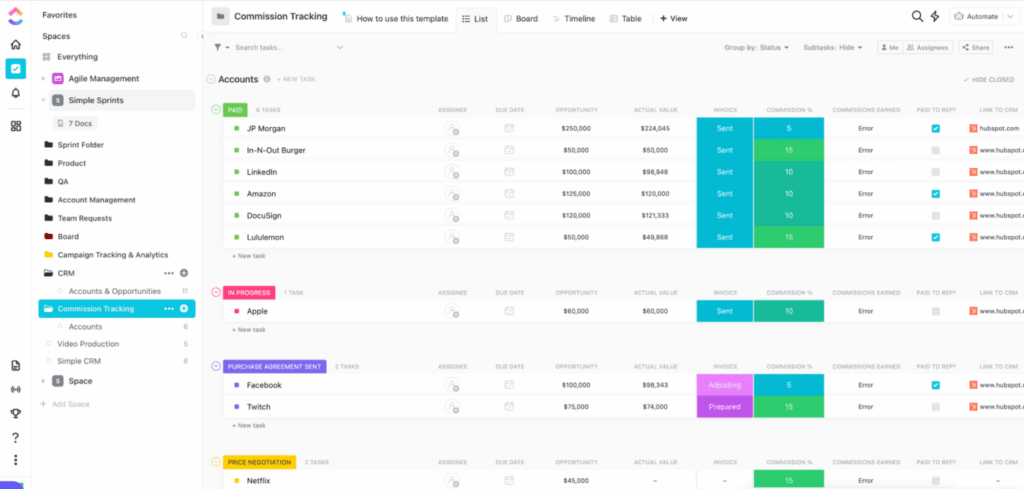
Supercharge Your Workflow: A Deep Dive into CRM Integration with ClickUp
In today’s fast-paced business environment, efficiency and organization are paramount. The ability to seamlessly manage customer relationships while keeping track of projects and tasks is no longer a luxury, but a necessity. This is where the powerful synergy of Customer Relationship Management (CRM) integration with project management platforms like ClickUp comes into play. This comprehensive guide will delve into the world of CRM integration with ClickUp, exploring its benefits, implementation strategies, and how it can revolutionize your workflow.
Understanding the Power of CRM and ClickUp
Before we explore the integration, it’s crucial to understand the individual strengths of CRM systems and ClickUp. CRM software acts as the central hub for all things customer-related. It stores customer data, tracks interactions, and provides tools for sales, marketing, and customer service. ClickUp, on the other hand, is a versatile project management platform that allows teams to organize tasks, manage projects, and collaborate effectively. When these two powerhouses are combined, the potential for streamlined operations and increased productivity is immense.
What is CRM?
CRM systems are designed to help businesses manage interactions with current and potential customers. They centralize customer data, allowing for better insights into customer behavior and preferences. Key features of a CRM typically include:
- Contact Management: Storing and organizing customer contact information.
- Sales Automation: Automating sales processes, such as lead tracking and deal management.
- Marketing Automation: Automating marketing campaigns and tracking their effectiveness.
- Customer Service: Managing customer inquiries and providing support.
- Reporting and Analytics: Providing insights into customer data and business performance.
Popular CRM platforms include Salesforce, HubSpot, Zoho CRM, and Pipedrive. Each platform offers a unique set of features and pricing plans, so choosing the right one depends on your business needs.
What is ClickUp?
ClickUp is a project management platform known for its flexibility and customization options. It allows teams to manage projects of any size, from simple to-do lists to complex, multi-faceted initiatives. Key features of ClickUp include:
- Task Management: Creating, assigning, and tracking tasks.
- Project Management: Organizing projects, setting deadlines, and monitoring progress.
- Collaboration: Facilitating communication and collaboration among team members.
- Reporting and Analytics: Tracking project performance and identifying areas for improvement.
- Customization: Adapting the platform to fit specific workflow needs.
ClickUp’s versatility makes it a popular choice for businesses of all sizes and industries.
The Benefits of Integrating CRM with ClickUp
Integrating your CRM with ClickUp offers a multitude of benefits that can significantly improve your business operations. Here are some of the key advantages:
Improved Data Accessibility and Accuracy
One of the primary benefits of integration is the ability to access customer data directly within ClickUp. Sales reps and project managers no longer need to switch between different platforms to find the information they need. This eliminates the risk of data silos and ensures that everyone has access to the most up-to-date information. By centralizing data, you also reduce the chances of errors that can occur when manually transferring data between systems.
Enhanced Collaboration and Communication
Integration fosters better collaboration between sales, marketing, customer service, and project management teams. With customer data readily available in ClickUp, project managers can easily understand customer needs and preferences, leading to more effective project planning and execution. Sales teams can stay informed about project progress and provide timely updates to customers. This improved communication leads to increased customer satisfaction and stronger relationships.
Streamlined Workflows and Increased Efficiency
Integration automates many manual tasks, freeing up your team to focus on more strategic initiatives. For example, you can automatically create tasks in ClickUp when a new lead is added to your CRM, or when a deal reaches a certain stage. This automation streamlines workflows, reduces the risk of errors, and saves valuable time. By eliminating repetitive tasks, your team can focus on more important activities that drive business growth.
Better Customer Insights and Personalization
By combining CRM data with project data, you gain deeper insights into your customers’ needs and preferences. This allows you to personalize your interactions and tailor your offerings to meet their specific requirements. For example, you can use CRM data to segment your customers and create targeted marketing campaigns. Project managers can use this information to customize project plans and ensure that they are aligned with customer expectations. This level of personalization leads to increased customer loyalty and satisfaction.
Data-Driven Decision Making
Integration provides a holistic view of your business, allowing you to make data-driven decisions. By analyzing data from both your CRM and ClickUp, you can identify trends, track performance, and measure the effectiveness of your initiatives. For example, you can track the impact of your marketing campaigns on sales, or identify bottlenecks in your project workflows. This data-driven approach enables you to optimize your operations and make informed decisions that drive business success.
How to Integrate CRM with ClickUp: Step-by-Step Guide
The process of integrating your CRM with ClickUp can vary depending on the specific CRM and the integration method you choose. However, the general steps are as follows:
1. Choose Your Integration Method
There are several ways to integrate your CRM with ClickUp. The most common methods include:
- Native Integrations: Some CRM platforms and ClickUp offer native integrations that allow you to connect the two systems directly. These integrations are typically easy to set up and offer a seamless user experience.
- Third-Party Integrations: Third-party integration platforms, such as Zapier, Integromat (now Make), and Tray.io, allow you to connect various applications, including CRM and ClickUp, without the need for coding. These platforms offer a wide range of pre-built integrations and customization options.
- API Integrations: If you have the technical expertise, you can use the APIs of both CRM and ClickUp to create a custom integration. This method offers the most flexibility but requires coding knowledge.
Choose the method that best suits your technical skills and business needs.
2. Select Your CRM and ClickUp Accounts
If you are using a native integration or a third-party integration platform, you will need to select your CRM and ClickUp accounts. You may need to enter your login credentials for both systems.
3. Configure the Integration
Once you have selected your accounts, you will need to configure the integration. This involves mapping data fields between your CRM and ClickUp. For example, you may want to map the customer name, email address, and phone number from your CRM to the corresponding fields in ClickUp. You will also need to define the triggers and actions that will be used to automate your workflows. For example, you may want to create a task in ClickUp when a new lead is added to your CRM.
4. Test the Integration
Before you launch the integration, it’s important to test it thoroughly. Create a test lead in your CRM and verify that the data is correctly transferred to ClickUp. Also, test the triggers and actions to ensure that they are working as expected.
5. Launch and Monitor
Once you are satisfied with the results of your testing, you can launch the integration. Monitor the integration regularly to ensure that it is working properly. You may need to make adjustments to the configuration as your business needs evolve.
Popular CRM Platforms and Their Integration with ClickUp
Here’s a look at some of the most popular CRM platforms and how they integrate with ClickUp:
Salesforce
Salesforce, a leading CRM platform, offers several integration options with ClickUp. You can use native integrations, third-party integration platforms like Zapier, or the Salesforce API to create a custom integration. The integration allows you to synchronize data between Salesforce and ClickUp, automate workflows, and track project progress within Salesforce.
HubSpot
HubSpot, known for its marketing and sales automation capabilities, also offers excellent integration options with ClickUp. You can use native integrations, third-party integration platforms, or the HubSpot API to integrate the two systems. The integration allows you to create tasks in ClickUp from HubSpot contacts, track deals, and manage projects related to specific HubSpot contacts.
Zoho CRM
Zoho CRM, a popular CRM platform for small and medium-sized businesses, offers integration options with ClickUp through third-party integration platforms like Zapier. The integration allows you to synchronize data, automate workflows, and manage projects related to Zoho CRM contacts and deals.
Pipedrive
Pipedrive, a sales-focused CRM platform, integrates with ClickUp through third-party integration platforms. This integration allows you to create tasks in ClickUp from Pipedrive deals, track project progress, and manage projects related to specific deals.
Best Practices for CRM and ClickUp Integration
To ensure a successful integration, follow these best practices:
1. Define Your Goals and Objectives
Before you start the integration process, clearly define your goals and objectives. What do you want to achieve by integrating your CRM with ClickUp? What data do you want to synchronize? What workflows do you want to automate? Having clear goals will help you choose the right integration method and configure the integration effectively.
2. Plan Your Data Mapping
Carefully plan how you will map data fields between your CRM and ClickUp. Consider which fields need to be synchronized and how the data will be transferred. Ensure that the data mapping is consistent and accurate to avoid errors and data silos.
3. Test Thoroughly
Before you launch the integration, test it thoroughly to ensure that it is working properly. Create test leads in your CRM and verify that the data is correctly transferred to ClickUp. Test the triggers and actions to ensure that they are working as expected.
4. Train Your Team
Provide training to your team on how to use the integrated system. Explain how to access and use the data, and how to use the automated workflows. This will ensure that your team can effectively utilize the integration and maximize its benefits.
5. Monitor and Optimize
Monitor the integration regularly to ensure that it is working properly. Identify any issues or errors and take steps to resolve them. As your business needs evolve, you may need to adjust the configuration of the integration to optimize its performance.
Advanced Integration Techniques and Customizations
Once you’ve established a basic CRM and ClickUp integration, you can explore advanced techniques to further streamline your workflow and leverage the combined power of the two platforms.
Custom Fields and Data Synchronization
Beyond the standard data fields, consider synchronizing custom fields that are specific to your business needs. For instance, if your CRM tracks customer lifetime value (CLTV), you can map this field to a custom field in ClickUp to provide project managers with a complete picture of the customer’s value. This enables more informed decision-making and personalized project management.
Automated Task Creation Based on CRM Stages
Implement workflows that automatically create tasks in ClickUp based on the stage a deal reaches in your CRM. When a deal progresses to the “Proposal Sent” stage in your CRM, for example, automatically create a task in ClickUp to follow up with the client and schedule a demo. This ensures that no action items are missed and that sales and project teams are aligned.
Two-Way Data Synchronization
While one-way synchronization (CRM data to ClickUp) is useful, consider setting up two-way synchronization. This allows data updates in either system to reflect in the other. For example, if a project manager updates a project’s status in ClickUp, the corresponding deal status in the CRM could automatically update. This ensures both teams have the most up-to-date information.
Conditional Logic and Triggers
Utilize conditional logic within your integration platform (e.g., Zapier) to trigger specific actions based on certain criteria. If a deal value in the CRM exceeds a certain threshold, you might automatically create a high-priority project in ClickUp with a designated project manager. This level of automation allows you to scale your operations and prioritize high-value projects.
Reporting and Analytics Dashboards
Leverage the reporting and analytics capabilities of both your CRM and ClickUp to create comprehensive dashboards that provide insights into your business performance. Visualize sales data alongside project completion rates to identify correlations and optimize your strategies. This data-driven approach can lead to significant improvements in both sales and project execution.
Troubleshooting Common Integration Issues
Even with the best planning and execution, you may encounter issues when integrating CRM with ClickUp. Here are some common problems and how to address them:
Data Synchronization Errors
Data synchronization errors can occur due to incorrect field mapping, data format inconsistencies, or API limitations. To troubleshoot, carefully review your field mappings, ensure that data formats are consistent across both systems, and check the API documentation for any limitations. You may need to adjust your configuration or use data transformation tools within your integration platform to resolve these issues.
Workflow Automation Failures
Workflow automation failures can be caused by incorrect triggers, actions, or conditional logic. Double-check your trigger settings to ensure that they are correctly configured and that they are firing under the expected conditions. Verify that the actions are correctly defined and that they are executing as intended. Review any conditional logic to ensure that it is accurate and that it is directing the workflow correctly.
Performance Issues
Performance issues, such as slow data synchronization or delays in workflow automation, can be caused by a variety of factors, including API rate limits, large data volumes, or inefficient integration configurations. To address these issues, optimize your integration by minimizing the number of API calls, batching data updates, and using efficient data mapping techniques. Consider upgrading your integration platform or increasing your API limits if necessary.
Security and Privacy Concerns
When integrating CRM with ClickUp, it’s crucial to address security and privacy concerns. Ensure that your integration platform uses secure connections and that it complies with relevant data privacy regulations, such as GDPR and CCPA. Protect sensitive data by using encryption, access controls, and other security measures. Regularly review your security settings and update them as needed.
The Future of CRM and ClickUp Integration
The integration between CRM and project management platforms like ClickUp is constantly evolving. As technology advances, we can expect even more sophisticated and seamless integrations in the future. Some trends to watch include:
Artificial Intelligence (AI) and Machine Learning (ML)
AI and ML are poised to play a significant role in the future of CRM and ClickUp integration. AI-powered integrations can automate more complex workflows, predict customer behavior, and provide personalized recommendations. ML algorithms can analyze data from both CRM and ClickUp to identify patterns and insights that can inform decision-making.
Enhanced Automation Capabilities
We can expect to see even more advanced automation capabilities, allowing businesses to automate a wider range of tasks and workflows. This will free up employees to focus on more strategic initiatives and improve overall efficiency.
Improved User Experience
Integration platforms will continue to focus on improving the user experience, making it easier for businesses to connect their CRM with ClickUp and other applications. This will include more intuitive interfaces, pre-built templates, and simplified configuration processes.
Greater Focus on Data Security and Privacy
With increasing concerns about data security and privacy, we can expect to see a greater focus on protecting sensitive data. Integration platforms will implement more robust security measures and comply with relevant data privacy regulations.
Conclusion: Unlock Your Potential with CRM and ClickUp Integration
Integrating your CRM system with ClickUp is a strategic move that can unlock significant benefits for your business. By combining the power of customer relationship management with project management, you can improve data accessibility, enhance collaboration, streamline workflows, gain better customer insights, and make data-driven decisions. While the initial setup might require some effort, the long-term rewards – increased efficiency, improved customer satisfaction, and accelerated business growth – are well worth the investment. By following the steps outlined in this guide and staying abreast of the latest trends, you can harness the full potential of CRM and ClickUp integration and propel your business to new heights. Embrace the power of integration, and watch your team thrive.

